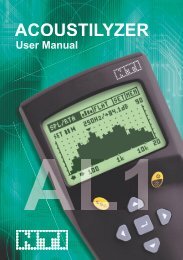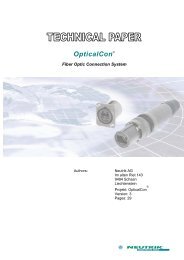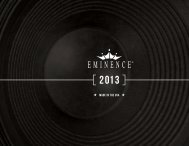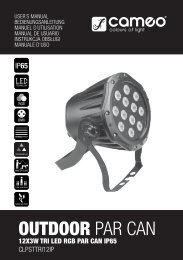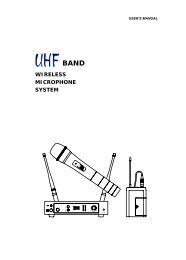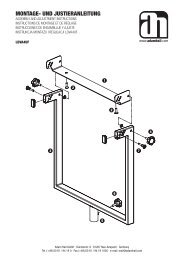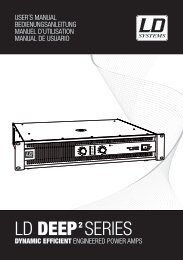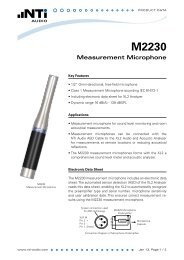Speech Intelligibility - Elma Instruments
Speech Intelligibility - Elma Instruments
Speech Intelligibility - Elma Instruments
You also want an ePaper? Increase the reach of your titles
YUMPU automatically turns print PDFs into web optimized ePapers that Google loves.
APPlicAtion note<br />
<strong>Speech</strong> <strong>Intelligibility</strong><br />
Measurement with XL2 Analyzer<br />
Public address systems in building complexes have to inform<br />
persons about escape directions in case of emergency. Such<br />
public buildings include airports, railway stations, shopping<br />
centers or concert halls. However if such announcements<br />
are misunderstood due to poor system quality, tragic consequences<br />
may result. Therefore, it is essential to design,<br />
install and verify sound reinforcement systems properly for<br />
intelligibility. In addition, a variety of other applications such<br />
as legal and medical applications may require intelligibility<br />
verification.<br />
STI, RASTI or STI-PA are the most established methods for measuring<br />
speech intelligibility. All of them basically apply the same<br />
principle, whereby RASTI and STI-PA are a simplified version of<br />
STI. This application note will explain the principles behind these<br />
methods.<br />
Index<br />
Subjective analysis methods 2<br />
Technical Methods 3<br />
STI - <strong>Speech</strong> Transmission Index 6<br />
RASTI - Room Acoustics <strong>Speech</strong> Transmission Index 6<br />
STI-PA - <strong>Speech</strong> Transmission Index for Public Address 7<br />
What is a TalkBox? / Do I need a TalkBox for STI-PA? 10<br />
STI-PA Test Result 11<br />
STI-PA Measurement Hints 12<br />
STI-PA Post Processing 13<br />
What to do if Impulsive Noise is permanently present? 14<br />
www.nti-audio.com Jun 10, Page 1 / 14
Subjective analysis methods<br />
APPlicAtion note<br />
National standards - see Figure 1 - require the verification of<br />
electro-acoustic sound systems for emergency purposes under<br />
realistic circumstances to ascertain a minimum level of speech intelligibility<br />
in case of an emergency. Thereby, speech intelligibility<br />
from a regulatory view is not a subjective measurement, but can<br />
be verified with several, more or less complex methods that have<br />
been standardized in IEC 60268-16.<br />
Other national or local regulatory bodies implement recommendations<br />
or requirements to conduct these measurements for maintaining<br />
minimum speech intelligibility.<br />
Standard: IEC 60268-16, Objective rating of speech intelligibility<br />
by speech transmission index<br />
National standards:<br />
ISO 7240 Fire detection and alarm systems, section 16 & 19<br />
NFPA 72 National Fire Alarm Code (2010 edition)<br />
BS 5839-8 Fire detection and alarm systems for buildings. Code of practice for<br />
the design, installation and servicing of voice alarm systems<br />
DIN 60849 System regulation with application regulation DIN VDE 0833-4<br />
Figure 1: A minimum of speech intelligibility is standardized<br />
Although frequency response, reverberation, distortion, signal-tonoise<br />
ratio or loudness are related to intelligibility, the conventional<br />
measurements of these parameters together only marginally<br />
relate to intelligibility. When added issues, such as directionality<br />
of drivers and the environment conditions are taken into consideration,<br />
the question is: How well a spoken message can be understood<br />
at different locations?<br />
The fundamental approach measuring intelligibility is to let a<br />
trained human speaker read a number of existing or synthetic<br />
words, whereas a representative number of listeners individually<br />
write down what they believe of having understood. The statistical<br />
analysis of these notes results in a value representing the<br />
percentage of words being understood correctly. Standardized<br />
procedures according to this method are PB-words, CVC or SRT<br />
(<strong>Speech</strong> Reception Threshold). However, conducting such tests<br />
is rather time consuming and costly, as well in some hazardous<br />
locations even impossible. Therefore, these methods are mainly<br />
used to verify alternate measurement methods.<br />
www.nti-audio.com Page 2 / 14
Technical Methods<br />
APPlicAtion note<br />
Already back in 1940, Bell Laboratories started to develop measurement<br />
technologies to determine the speech intelligibility.<br />
Nowadays, highly developed algorithms as SII (<strong>Speech</strong> <strong>Intelligibility</strong><br />
Index) and various forms of the STI (<strong>Speech</strong> Transmission<br />
Index) allow measuring speech intelligibility. These techniques<br />
take care of many parameters which are important for intelligibility<br />
such as:<br />
• <strong>Speech</strong> level<br />
• Background noise level<br />
• Reflections<br />
• Reverberation<br />
• Psychoacoustic effects (masking effects)<br />
The basic idea of STI measurement consists in emitting a synthesized<br />
test signals instead of a human speakers voice. The speech<br />
intelligibility measurement acquires and evaluates this signal<br />
as perceived by the listeners ear. Extensive investigations have<br />
shown the relationship between the alteration of speech characteristics<br />
and the resulting speech intelligibility. These findings<br />
are incorporated into the speech intelligibility meter that is able<br />
to display the intelligibility result as a single number between 0<br />
(unintelligible) and 1 (excellent intelligibility).<br />
Figure 2: <strong>Speech</strong> <strong>Intelligibility</strong> may be expressed by a single number value. Two scales<br />
are most commonly used: STI and CIS (Common <strong>Intelligibility</strong> Scale)<br />
www.nti-audio.com Page 3 / 14
Figure 3: Average octave band spectrum of<br />
a male speaker<br />
Figure 4: Envelope of a speech signal (250<br />
Hz band).<br />
Figure 5: Frequency spectrum of the envelope<br />
(250 Hz band).<br />
<strong>Speech</strong> model<br />
APPlicAtion note<br />
First of all, measuring the speech intelligibility requires a model<br />
for speech signals. For instance, speech may be described as a<br />
time evolution of various spectra. Superposition of all spectras<br />
defines the long-term speech frequency spectrum. Evolution in<br />
time is modulated as a set of intensity modulation.<br />
Time modulation<br />
Level of frequency components varies, i.e. is “modulated” by the<br />
speaker. Figure 4 shows the envelope of a speech signal in the<br />
250 Hz octave band. The shape of the envelope is given by averaging<br />
the time evolution of the speech contents.<br />
Frequency spectrum<br />
The spectral analysis of a male voice averaged over a longer time<br />
results in a typical characteristic as shown in Figure 3.<br />
Analyzing the spectra of time modulation intensity shows that a<br />
speaker modulates the speech spectra with frequencies in the<br />
range from 0.1 to 24 Hz. A set of modulation frequencies from<br />
0.63Hz to 12.5Hz sufficiently represents these modulations.<br />
Modulation Transfer Function (MTF)<br />
High speech intelligibility needs the spectral intensity modulation<br />
and the overall spectrum being preserved at reaching the listeners<br />
ears. Therefore, the three core intelligibility measurement methods<br />
STI, RASTI and STI-PA are based on measuring the MTFs<br />
(Modulation Transfer Functions) in 7 octave bands. For each octave<br />
band is one MTF quantifying the preservation degree of the<br />
intensity modulations in this band. These functions quantify how<br />
much the intensity modulations are preserved in 7 octave bands<br />
covering the long-term speech spectrum.<br />
www.nti-audio.com Page 4 / 14
Modulated Octave Band Noise<br />
Modulation Index = 1<br />
Reverb<br />
Reflections<br />
APPlicAtion note<br />
Resulting signal<br />
Modulation Index = 0.5<br />
Modulation Transfer Function for one octave band<br />
Reverb<br />
Reflections<br />
Figure 6: Reverberation, background noise and reflection are responsible for degrading<br />
of the modulation index.<br />
Figure 7 shows the MFT of one octave band. This is derived from<br />
Modulated Octave measuring Band Noise the 1/3rd octave modulation frequencies, Resulting thus resultsignal<br />
Modulation Index ing in = 14 1 frequencies between 0.63 and 12.5 Hz. Each Modulation modulation Index = 0.5<br />
transfer function determines how well the modulations are preserved<br />
in the associated octave band.<br />
Modulation Transfer Function for one octave band<br />
Figure 7: Modulation Transfer Function for one octave band<br />
Based on the MTF results as well as sound pressure level, octave<br />
band depending hearing threshold, frequency response and<br />
psycho acoustic effects (masking effects) it becomes possible to<br />
reliably determine the preservation of speech intelligibility from<br />
speaker to listener. The calculations are based on extensive and<br />
profound evaluations and comparisons with subjective methods.<br />
Measuring the complete MTF – as required for STI – can become<br />
rather time consuming. For instance, 14 * 7 = 98 individual measurements<br />
must be executed, thus resulting in a total acquisition<br />
duration of 15 minutes. Therefore, different approaches have been<br />
developed to reduce test duration and to enable speech intelligibility<br />
measurements with portable instruments.<br />
www.nti-audio.com Page 5 / 14
STI - <strong>Speech</strong> Transmission Index<br />
RASTI - Room Acoustics <strong>Speech</strong> Transmission Index<br />
APPlicAtion note<br />
The STI result is based on the full set of 98 measurements. Since<br />
this approach requires a rather long test period, it is less frequently<br />
applied in practice. However, STI represents the most detailed<br />
method to measure the preservation of speech intelligibility during<br />
transmission and is mostly used if alternative approaches<br />
don’t provide reliable results due to unfavorable environmental<br />
conditions.<br />
Figure 8: STI considers all 14 modulation frequencies and all 7 octave bands resulting in<br />
98 modulation index results.<br />
In practice, the STI result is mostly calculated from the impulse<br />
response (MLSA) that has been acquired e.g. with a PC-based<br />
system. This approach is much quicker, but requires post-processing<br />
with spectral frequency weighting and lot of experience.<br />
The measurement assumes a linear behavior of the setup, i.e.<br />
there must be no non-linear processing or conditions, including<br />
compressors or limiters and close to zero wind speeds, which is<br />
a rather rare situation. Microphone and speakers aren’t allowed<br />
for movements during measurement. As handheld instruments<br />
aren’t fixed during measurement, it doesn’t make sense to support<br />
MLS testing in handheld instruments.<br />
RASTI has been developed for special cases, such as a human<br />
lecturer speaking into a small room without echo’s, but not for<br />
electro-acoustic systems.<br />
In order to cope with the long test time required for each STI measurement,<br />
a faster method called RASTI was developed. But this<br />
in turn weakens its ability for comprehensive testing and heavily<br />
compromises its resistance against outside interference. This also<br />
leads to poor correlation between subjectively evaluated STI and<br />
RASTI. However, RASTI used to be the only method to measure<br />
the quality of speech transmission with a portable instrument for<br />
a long time, thus it has been utilized in the aviation industry to<br />
measure public announcement systems, disregarding the above<br />
mentioned development restrictions of RASTI.<br />
RASTI acquires only few segments of a complete MTF table, which<br />
www.nti-audio.com Page 6 / 14
STI-PA - <strong>Speech</strong> Transmission Index for Public Address<br />
APPlicAtion note<br />
obviously represents an extreme simplification of STI. Therefore,<br />
tight restrictions must be met to acquire reliable speech intelligibility<br />
results with RASTI. Furthermore, the RASTI result does not<br />
consider significant parameters such as the frequency response,<br />
echoes or frequency-dependant reverberation times. For a RAS-<br />
TI measurement, only two simultaneously generated frequency<br />
bands are considered, i.e. the 500 Hz and the 2 kHz band which<br />
then are modulated with four and five frequencies respectively.<br />
Figure 9: RASTI uses 9 different modulation frequencies in 2 octave bands. The yellow<br />
marked octave bands and modulation frequency<br />
The practical application of RASTI is mainly restricted to quantify<br />
the intelligibility index of the channel between two persons. However,<br />
RASTI used to be the only method to measure the speech<br />
intelligibility with a portable instrument for a long time, thus it has<br />
been utilized in the aviation industry to measure public announcement<br />
systems.<br />
A rising awareness for security issues, new technological means<br />
and the shortcomings of RASTI triggered the speaker manufacturer<br />
Bose and the research institute TNO to develop a new method<br />
for speech intelligibility measurements of PA installations. The<br />
result of these efforts is STI-PA, which allows quick and accurate<br />
tests with portable instruments.<br />
Like RASTI, STI-PA applies a simplified procedure to calculate the<br />
MTF. But STI-PA determines one MTF by analyzing all seven frequency<br />
bands, whereby each band is modulated with two frequencies.<br />
Figure 10: The IEC60268-16 describes a STI-PA method where the 125Hz band and<br />
250Hz band are combined and the yellow marked modulation frequencies are not considered.<br />
www.nti-audio.com Page 7 / 14
APPlicAtion note<br />
Supposing that no severe impulsive background noise is present<br />
and that no massive non-linear distortions occur, STI-PA provides<br />
results as accurate as STI. If however impulsive background noise<br />
is present during the normal system operation hours, it is usually<br />
possible to mitigate the effects by also acquiring a measurement<br />
at a more favorable time e.g. under slightly different conditions in<br />
the area, or during the night time - and to calculate an unbiased<br />
overall measurement by using the results of both test cycles.<br />
Figure 11: The NTi Audio-STI-PA method (verified by TNO) considers all 7 octave bands<br />
and all 14 modulation frequencies resulting in slightly more accurate results than the IEC<br />
STI-PA method.<br />
How does STI-PA compare to STI and RASTI<br />
STI measured in public address systems has been very time<br />
consuming. A complete set of 98 measurements of modulation<br />
transfer functions (MTF) has to be obtained and summed. Due to<br />
the complex nature and the time required almost no really useful<br />
STI measurement systems were available for years. With the appearance<br />
of MLS based systems, STI was more often obtained,<br />
as it can be calculated out of the transfer function, as long as<br />
the entire system is strictly linear and synchronous, i.e. there<br />
must not be any non-linear processing or conditions, including<br />
compressors or limiters and close to zero wind, which is a rather<br />
rare situation. Microphone and speaker aren’t allowed for movements<br />
during the measurements, which prohibits employment<br />
of handheld instruments. Thus it doesn’t make sense to support<br />
MLS measurements in handheld instruments. Alternatively by using<br />
the dedicated STI-PA test signal, measurements can be accomplished<br />
with handheld instruments.<br />
STI-PA, a derivative of STI, has been developed specifically to cope<br />
with the non-linear processing environment common to advanced<br />
sound systems, and to reduce the measurement time required to<br />
a practical level.<br />
www.nti-audio.com Page 8 / 14
APPlicAtion note<br />
Calculation of % Alcons from STI-PA Measurement<br />
Alcons (%) = 10^((1-STI)/0.45)<br />
The calculation of STI-PA based on Alcon measurements is not<br />
reasonable due to the difference in the measurement principles.<br />
Now STI-PA<br />
A rising awareness for security issues, new technology, and the<br />
shortcomings of RASTI together triggered the speaker manufacturer<br />
Bose and the research institute TNO to develop a new<br />
method for measuring the quality of speech transmission of PA<br />
installations. The result of these efforts is STI-PA, which supports<br />
fast and accurate tests with portable instruments. STI-PA stands<br />
for <strong>Speech</strong> Transmission Index for Public Address systems.<br />
Portable STI-PA analyzers, e.g. NTi Audio’s XL2 Audio and Acoustic<br />
Analyzer, are able to evaluate speech intelligibility within 15<br />
seconds per room position and are thus well suited for wide-area<br />
measurements and high productivity.<br />
Who can and should conduct STI-PA measurements?<br />
Even though the background of the STI-PA method is complex,<br />
the operation of STI-PA using the XL2 Audio and Acoustic Analyzer<br />
is very simple. Operators with a basic acoustic knowledge can<br />
easily conduct these measurements. The instrument’s internal<br />
storage functionality also simplifies the measurements in larger<br />
buildings, where many measurements at many locations must<br />
be taken. The detailed access to the measured MTF (Modulation<br />
Transfer Function) matrix enables experts to post-process all measurement<br />
data.<br />
Is this a research product or widely used?<br />
STI-PA is the standardized result of extensive scientific research.<br />
But unlike RASTI, within two years as many as four international<br />
test instrument manufacturers have implemented the STI-PA approach<br />
and offer varying solutions. It is therefore perfectly valid<br />
to say that STI-PA is the widely accepted standard for measurements<br />
of the quality of speech transmission, combining the accuracy<br />
and advantages of full STI measurements with the benefit<br />
of extremely short measurement time of only 15 seconds per<br />
location.<br />
www.nti-audio.com Page 9 / 14
Who is TNO?<br />
APPlicAtion note<br />
TNO is a research and certification institute in the Netherlands,<br />
Europe. They are focusing on research around defense, security<br />
and safety and they have originally developed the STI as well as<br />
the STI-PA technology. Their knowledge is freely useable and not<br />
patent protected.<br />
Compatibility?<br />
Thanks to TNO, acting as a certification body, it is guaranteed that<br />
instruments from all certified test and measurement vendors will<br />
provide compatible measurement results. Three vendors are currently<br />
certified by TNO. Studies and comparisons conducted by<br />
Peter Mapp Associates, Colchester, Essex UK, confirmed that all<br />
certified vendors provide stable and comparable measurement<br />
results. Details of the comparison may be found in the AES publication<br />
titled “Is STI-PA a robust measure of speech intelligibility<br />
performance?”<br />
Patent protected?<br />
Even though the research part of STI and STI-PA is not patent<br />
protected, BOSE of America has been recently been granted the<br />
US-Patent 6,792,404B2 for the idea to implement STI or STI-PA<br />
onto a hand held analyzer. NTi Audio maintains a license agreement<br />
with BOSE for this patent and is therefore able to market<br />
the STI-PA implementation available for the XL2 Audio and Acoustic<br />
Analyzer in the US.<br />
Can I buy STI-PA for my XL2?<br />
What is a TalkBox? / Do I need a TalkBox for STI-PA?<br />
Yes, STI-PA is an optional function for the XL2 Audio and Acoustic<br />
Analyzer. Any XL2 user may obtain a STI-PA license. With the key<br />
of the license he may request the activation key for his XL2 Audio<br />
and Acoustic Analyzer and full functionality is then activated.<br />
The TalkBox is NTi Audio‘s calibrated acoustical sound source with<br />
built in digital solid state signal generator. You don’t necessarily<br />
need a TalkBox if you are testing only the portion of the system<br />
beyond the microphone. But the use of the NTi Audio TalkBox as<br />
speaker substitute is advisable if:<br />
•<br />
Regulations require a complete end-to-end system check in-<br />
www.nti-audio.com Page 10 / 14
NTI TalkBox<br />
STI-PA Test Result<br />
APPlicAtion note<br />
cluding the microphone. This is the most realistic system check<br />
in any event.<br />
• No electrical input is available to induct the electrical test signal.<br />
• The level of the test signal is not clearly defined<br />
• The characteristics of the speaker’s acoustical environment are<br />
not negligible and flat.<br />
• The characteristics, sensitivity and frequency response of the<br />
speaker’s microphone is not known but needs to be considered.<br />
• As above, if for any other reason it is desirable to test the entire<br />
signal chain under real conditions.<br />
• The TalkBox is also capable of delivering white and pink noise<br />
and other special signals, and so is a very useful overall tool for<br />
system tuning and testing.<br />
• The intelligibility index is measured in the range from 0 to 1,<br />
whereby 1 is perfect and the minimum requirement including<br />
measurement uncertainty and variation is >= 0.5.<br />
• The variation of STI-PA test results shall be smaller than 0.03<br />
STI at one test position, thus to fulfill measurement conditions<br />
for ambient noise characteristics. The actual variation shall be<br />
measured at a representative location.<br />
• Best intelligibility is achieved at message levels in the range<br />
of 70-80 dBSPL. At higher sound pressure levels the selfprotection<br />
of the ear comes into action, which is reflected in<br />
a reduced intelligibility index, such as a STI of 1 at 70 dBSPL<br />
may be down to 0.7 STI at higher sound pressure level.<br />
• Based on the random STI-PA test signal the typical variations<br />
of the measurements is 0.01 – 0.03 STI. Thus at applications<br />
with STI-PA values < 0.63 STI the measurement has to be<br />
repeated twice and the arithmetical average of all 3 measurements<br />
calculated.<br />
• In case variations are higher than 0.03 STI, further 3 measurement<br />
shall be carried out and all 6 readings arithmetical averaged.<br />
• In case variations at the same test location are higher than<br />
0.05 STI, causes for these discrepancies shall be detected,<br />
eliminated and the measurement repeated.<br />
www.nti-audio.com Page 11 / 14
STI-PA Measurement Hints<br />
APPlicAtion note<br />
• Any background noise has to be sufficiently static during the<br />
measurement, e.g. pink noise fulfills this requirement.<br />
• Verify the environmental conditions prior testing. Complete<br />
STI-PA measurements without any test signal. The results shall<br />
be < 0.20 STI.<br />
• Impulsive background noise during the measurement, such as<br />
speech, cause severe measurement errors. The STI-PA result<br />
is usually too high.<br />
• In case such an impulsive noise cannot be prevented, the measurements<br />
might be shifted e.g. to night time, and afterwards<br />
corrected with the averaged daily background noise, using<br />
external post processing.<br />
• Any CD-Players used to reproduce the STI-PA test signal have<br />
to be accurate as only limited time-shifts (+/- 200 ppm) are<br />
allowed to ensure reliable STI-PA test results. Pitch control<br />
and shock protection shall be disabled. Thus only professional<br />
players shall be used. You may verify the time shift of your CD-<br />
Player with a 1 kHz test signal:<br />
• Insert the NTi Audio Test CD into the CD player and start track<br />
1, which is the 1 kHz test signal.<br />
• Connect the XL2 directly to the audio output and measure the<br />
signal frequency in the RMS/THD mode. The displayed frequency<br />
shall be in the range from 0.9998 kHz to 1.0002 kHz<br />
• STI-PA test signals of other test system manufacturers may<br />
sound similar but are not compatible. Only the NTi Audio STI-<br />
PA test signal CD V1.1 or higher shall be used in combination<br />
with the XL2.<br />
• STI-PA measurement of alarm systems should be carried out<br />
at emergency conditions (same sound pressure level and all<br />
components are activated).<br />
• At locations with varying conditions e.g. some public areas<br />
with few people; others with crowds -- the worst case STI-PA<br />
results should be measured. Consult your local regulations<br />
(e.g. in the U.S., the NFPA code) for specific directives concerning<br />
measurement locations and number of required total<br />
STI-PA measurements under different circumstances.<br />
• Select typical locations based upon such regulations, or typically<br />
position the microphone at 1 - 1.2 meters above ground<br />
in sitting areas or 1.5 - 1.8 meters in standing areas (typical<br />
measurement positions are normally not directly in front of the<br />
speakers).<br />
www.nti-audio.com Page 12 / 14
STI-PA Post Processing<br />
APPlicAtion note<br />
• The person taking the measurements should be out of the<br />
acoustic field, so not affecting the measurement results. For<br />
this purpose the measurement microphone can be mounted<br />
on a microphone stand and connected with the ASD-Cable to<br />
the XL2.<br />
• Low STI-PA readings can be caused by<br />
• Excessive sound reverberation, echoes or reflections<br />
• Poor speaker directivity or speaker coverage<br />
• Speaker power setting not in order (e.g. low signal-to-noise<br />
ratio)<br />
Measuring the speech intelligibility index under realistic environment<br />
conditions is often not applicable, e.g. playing the test signal<br />
in a railway station at emergency levels during peak hours will irritate<br />
passengers. Additionally at rush hours the characteristics of<br />
back ground noise might be highly impulsive. But a pre-requisite<br />
for accurate STI-PA measurements is a negligible impulsivity in<br />
the background noise.<br />
Under such circumstances the STI-PA measurement should be<br />
shifted to a more suitable time of the day, e.g. night time. Such<br />
STI-PA measurements taken at untypical background noise conditions<br />
have to be post-processed. Post processing combines<br />
the STI-PA measurement data taken at quasi noise-free ambient<br />
conditions with the unweighted time-averaged octave band noise<br />
levels (Leq) taken e.g. during day time, at realistic environmental<br />
conditions.<br />
The NTi Audio STI-PA Post Processing Software is tailored for<br />
this application e.g. to combine the night and day-time measurement.<br />
“NTi_Audio_STI-PA_PostProcessing.xlt” is available for download<br />
at “www.nti-audio.com/XL2”<br />
(Enable all macros at opening the document.)<br />
www.nti-audio.com Page 13 / 14
What to do if Impulsive Noise is permanently present?<br />
APPlicAtion note<br />
In a 24 hours factory or on a highway impulsive noise may be permanently<br />
present, thus STI-PA measurements shall not be carried<br />
out. In such instances the onsite conditions have to be simulated<br />
in a laboratory for STI-PA testing:<br />
• The real noise spectrum shall be measured e.g. with the XL2<br />
Audio and Acoustic Analyzer SLM function, averaging over a<br />
sufficient amount of time.<br />
• A diffuse sound field of non-impulsive noise with same frequency<br />
shape and octave band levels as measured has to be<br />
generated in the laboratory.<br />
• The real speaker - listener situation has to be reproduced<br />
acoustically in the laboratory as close as possible.<br />
• Then the actual STI-PA measurement can be carried out. No<br />
post processing is required.<br />
This approach will also be mandatory for systems including automated<br />
gain control (AGC), if they can’t be tested in the original environment<br />
due to annoyance of people exposed to the test signal<br />
due to the impulsive background noise.<br />
Further Information:<br />
For further information please visit www.nti-audio.com.<br />
Detailed information on speech intelligibility measurements are<br />
contained in the IEC60268-16 (2003-5) standard, which also describes<br />
the test procedures and the requirements in practice.<br />
www.nti-audio.com Page 14 / 14



